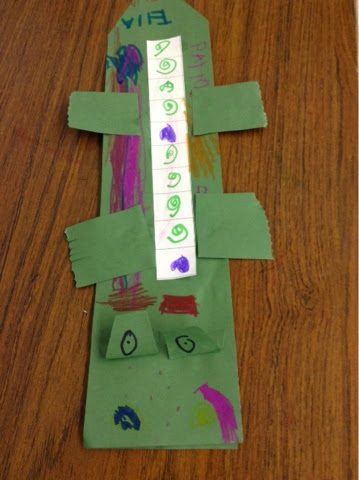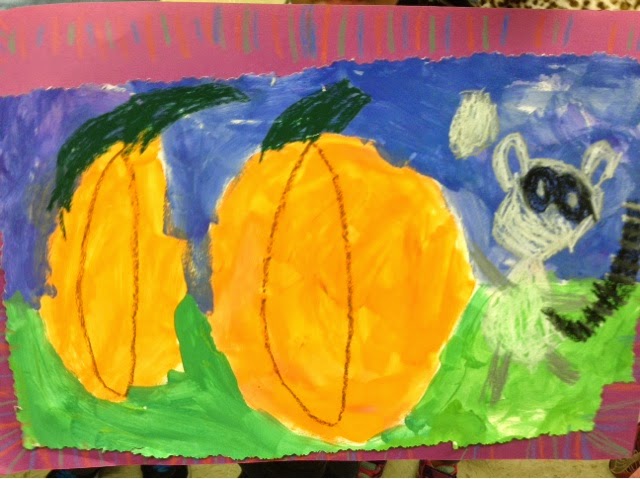Kindergarteners talked about patterns to make these alligators. On day one, we drew the pattern, cut the tail, the eyes, and decorated the back. On day two, we added the legs, decorated the legs and belly, and made his mouth open and close. I read There's An Alligator Under My Bed to the students as well.
Friday, November 21, 2014
1st Grade Still Life Cornucopia
1st graders created still lifes from Cornucopias. We discussed how a still life is a picture of art that does not move and food is the perfect example. I had templates for students to trace to make the actual cornucopia, but they added the lines to make it 3-d and decided what food should go in heir still life.
1st Grade Batik Leaf
We discussed how you can make your own paper from pulp and that when you do this there is usually a lot of texture. Now sadly we didn't make our own paper for this project. We took computer paper and drew a leaf in the middle using pencil. We then went over our lines with sharpie. Next we colored in our leafs with crayon. Now for the fun part. We took our paper and crumbled it up, opened it up, and crumbled it up again. Students thought I was crazy when I gave them theses directions. Last we smoothes out the paper as much as possible and painted it with a blue sparkly wash.
2nd Grade Texture Leaves and Pendants
2nd graders focused on texture when creating these leaf plates and pendants. We pressed a leaf onto a slab of clay and carefully cut around it to make the plate. We then used he bottom of our shoes to make the pendants. After the clay was fired, students painted using watercolors.
4th Grade- Tint and Shade Trees
4th graders learned about tints and shades and created these moon light whimsical trees. We started with white paint and gradually added the hue. Once we met the pure hue, we gradually added black to get a color value scale. On the second day, we talked about silhouettes and created a tree using black paint.
Monday, November 17, 2014
5th Grade Contour Lines
This was a one day filler project. Fifth grade created non-objective artwork by using contour lines.
Friday, November 7, 2014
3rd Grade Realistic Drawings
3rd grade studied artwork by Albrecht Durer and focused on how detailed and realistic his drawings are. We then studied plants, leaves, and twigs and created our own realistic drawings. Lastly, we printed leafs on our artwork using gold paint.
1st Grade 3-D Pumpkins
You know those Chinese Lanterns you used to make? Well we took that idea and turned them into 3-D pumpkins. Students worked hard to use rulers, cut straight lines, use glue with control, and curled paper for the vines. You can even see that some students added details with markers to turn their pumpkins into jack-o-lanterns.
1st grade- Secondary Color Pumpkins
1st graders mixed primary colors to make secondary colors. I love how the students get so excited when they mix colors and the color changes. We used the secondary colors to paint our picture... Pumpkins, grass, and sky. The next class, we cut the edge of our painting with fancy scissors, glued it to a background paper, added details with oil pastels, and a pattern for he boarder. I love all the creatures students thought to add, especially the raccoon in the second picture.
4th Grade Relief Sculpture Houses
4th graders learned about relief sculptures, sculptures that stick out on the front but are flat on the back. We then created relief sculpture houses. The students love this project and the think of new pop out ideas each year. I love how the first student even made a 3-D tree. 


5th Grade Moonlight Pumpkins
We had just finished up a long architecture unit (5 class periods) so unwanted to do a simple project that students could create and take home. Besides, I love fall projects.
5th Grade Clay Houses
This is an all time favorite project for the kids. 5th graders study American Architecture such as
porches, balconys, chimneys, etc. they then plan their own house that they create with clay. We use a milk carton for the base of our house and use additive and subtractive sculpture methods. After the clay has been fired, students paint their projects.
3rd grade Victorian Houses
3rd graders studied artwork by Edward Hopper, focusing on his Victorian Houses. We then created our own spooky Victorian Houses.
Kindergarten- Symmetrical Pumpkins
Kindergarten made symmetrical pumpkins by painting one side of there paper and folding it. The next class, students added details including grass, background, stems, and faces.
Subscribe to:
Comments (Atom)















































